Pros
Cons
I was a huge fan of Paper Mario (2000) and Paper Mario: The Thousand-Year Door (2003), but like many fans of those masterful RPGs, I had some misgivings about 2007's action-oriented Super Paper Mario.
Five years later, Sticker Star became available to 3DS owners via download or retail purchase on November 11th, 2012.
This review is based off of roughly 40 hours of play time with Paper Mario: Sticker Star. The reviewer has played each game in the Paper Mario series, and is judging from both a series and a standalone game perspective. All screenshots and images are courtesy of Nintendo and Intelligent Systems.
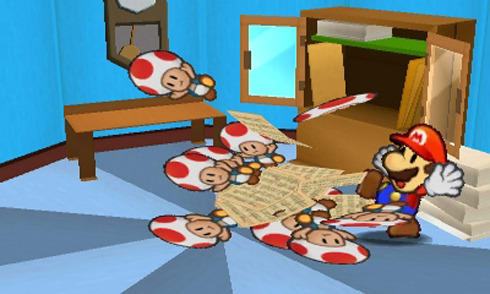
Mario, your Toad cabinet looks to be infested with some papers.
To get this out of the way immediately, let me discuss what's been changed. If you buy Sticker Star expecting the spiritual or literal successor to the first or second game in the series, you will be sorely disappointed. It's as different from the original as Super Paper Mario was.
Is that a bad thing? Not necessarily... though I know many fans who are still direly holding out for the day when Intelligent Systems returns to the depth and sweeping narrative of the first two games.
Sticker Star has no leveling up, no experience points, no consumable items, no cooking, and no partners. Like many fans, I was very shocked when I heard this—the series' partner-based combat and dialogue is perhaps its most enjoyable and endearing feature.
While Sticker Star is still an RPG, if only because of its turn-based combat, it does away with many of the series' staples in favor of an experience more tailored to the 3DS handheld console. Rather than one persistent world to explore, areas are broken up into "worlds" and "stages" (in lieu of the "chapters" from the first game).
Nintendo's Kensuke Tanabe explained in a recent developer interview that, "My personal reason for choosing the fixed level style was to make it easy for you to stop playing at any time... The simple fact that it is a Mario game also makes this kind of fixed level style a possibility... I believe that the player will feel like there is an open-world structure to the game since actions in one level become the key to solving puzzles in others."
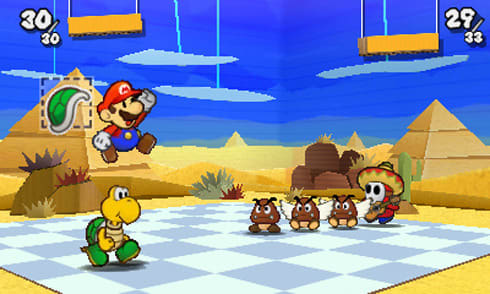
Is that Koops from TTYD? No… just a generic Koopa Troopa.
Like many players, I swallowed my initial disappointment that the game was going to be something other than a carbon copy of The Thousand-Year Door and decided to look at it with a new perspective. It felt kind of like when your favorite musical artist releases that mid-life crisis R&B album—a divergence from the status quo.
Just after midnight on November 11th, I downloaded Sticker Star with a cautious excitement and jumped right in.
My initial impressions—beyond the childish excitement of simply playing any new video game—were not favorable. Sticker Star does little to separate its story from so many Mario games before it.
In Paper Mario's universe, it's the day of the annual Sticker Fest, where residents gather to celebrate and offer their wishes to the sanctified and titular "Sticker Star," a comet that is also a sticker. Something happens involving Bowser, Peach, etc. You know the drill.
Like so many times before, Mario is tasked with fixing what has been un-fixed. With that, you're dropped into the wreckage of the Sticker Fest and the game begins. From here, the game's sticker-centric narrative/combat is introduced.
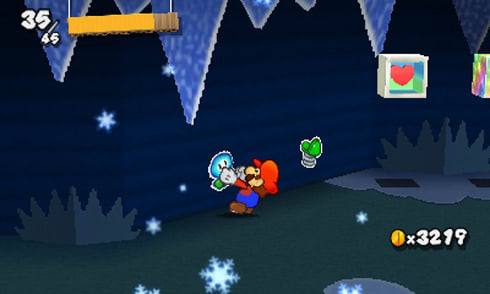
Stickers are stuck up everywhere throughout the game’s paper world.
Sticker-based combat is a unique and interesting take on the game's turn-based system. Mario collects stickers—Jump, Hammer, Fire Flower—that are found in blocks, stuck on walls, or bought in shops. These stickers are placed in a Sticker Album, which slowly grows larger over the course of the game.
Mario must then use, or "consume," a sticker during battle to attack his enemies. For instance, a Line Jump sticker allows Mario to jump on each enemy in a row.
Returning to the series is a feature that was absent in Super Paper Mario: Action Commands. As a veteran of the Paper Mario games, I can purport that I'm no slouch when it comes to action commands, and yet the action commands in Sticker Star are notably more difficult, in some cases, than they were in previous titles.
For those who don't know, Action Commands involve pressing the A button at a set time during an attack or defensive maneuver to either increase the damage you deal, or decrease the damage you take.
There are various "levels" of combat stickers. For example, the basic Jump sticker has a number of variations. From weakest to strongest, they are: Worn-Out Jump, Jump, Shiny Jump, Flashy Jump, and Megaflash Jump. There are also Iron Jump stickers, Line Jump stickers, Hopslippers... You can imagine how long the completed list is.
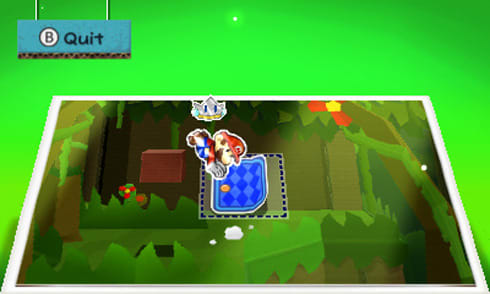
“Paperization,” pictured above, plays a big part in Sticker Star, and is essential to progressing.
Perhaps the second most unique aspect about Sticker Star is the use of "paperization," wherein your Navi-esque partner Kersti flattens out the paper world from a 3D "pop-up" style to a 2D... paper style. Bear with me. From this vantage point, Mario is able to apply his stickers directly to the world, adjust paper objects in the background, and get a glimpse into the terrifying lime green aether that is the "no-thing" around his universe.
Paperization is used mainly for puzzles. Speaking of puzzles, let me offer you some first-hand advice: If you're planning on picking up Sticker Star you may want to consider also grabbing the guide. The game absolutely does not hold your hand in any way, and often the clues as to what you're supposed to do to solve a puzzle are obscure or non-existent ( Myst, anyone?).
I applaud Intelligent Systems for making me think, but for some puzzles I absolutely had to resort to the guide. It bordered on frustrating, but I preferred it to things being too easy.
Paperization will often allow Mario to "repair" his paper world where some baddie has negatively altered something. In the first World, Bowser Jr. steals a bridge and Mario is unable to get to where he needs to go. Paperization allows Mario to locate the bridge (with the help of a stack of Toads), and then lift and line its shadow up with a neon-purple tear in the fabric of paper-time... the bridge can be "re-stuck" to the world this way, and becomes a real object again.
Paperization is a very common element throughout the entire game—if you find yourself stuck, try triggering paperization. The answer is often clear afterward.
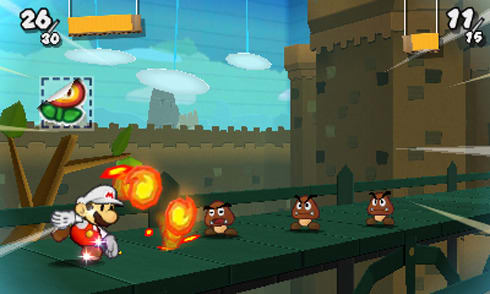
Those goombas won’t know what hit ‘em. (hint: it’s fireballs)
Sticker Star is a Paper Mario game, but it's not the game some fans wanted. I've been lurking on various forums, and it's clear that people are very divided as to this title's value. Some are arguing it's the best game in the series; some that it's an unpalatable mess. The truth is, of course, that it's somewhere in the middle. The sticker combat and paperization make for fun game mechanics. Likewise, the puzzles are challenging and exploration is rewarding.
On the surface, Sticker Star is a very fun game, and a decent standalone title. It even makes good use of the 3DS' glasses-free 3D. My biggest problem with it, though, has to do with what's underneath that surface shine: nothing.
There's no persistent narrative, no relationships are built, and there's almost nothing "extra" to the game. I think Intelligent Systems poured as much love as they could into the game, but Nintendo told them no "original characters," and the stifled creativity shows through at the end of the day.
I think Sticker Star is a good game. I enjoyed playing it, but I also went in guarding my heart against the disappointment that my favorite game of all time—Paper Mario—was going to remain firmly planted in the year 2000. The game comes packaged with some very creative and innovative mechanics, but it isn't a true RPG.
You won't feel as though you're undertaking a very serious journey, and you won't feel as though you (or Mario) have grown much by the end of it. It is a zero-sum gain, unfortunately. But it's a fun zero-sum gain.
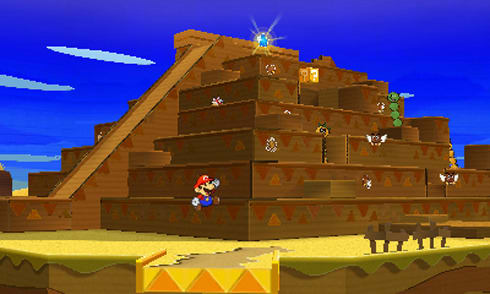
I’m getting a very Super Mario 64 vibe.
Essentially, if you loved the early Paper Mario games for their deeply woven narratives, interrelation between Mario and the personality-heavy characters he meets, and a spreadsheet-style RPG experience, Sticker Star may not be the best game for you.
Yet all of Intelligent System's humor, wit, and subtle charm are still present, even if their characters aren't, and the sticker/paperization mechanics are an entertaining and fresh take on traditional turn-based combat and puzzle solving.
Any 3DS owner or Mario fan will certainly find something to like, or laugh at, in Sticker Star. But for those of you who long for a return to the high-quality standards set by the first two games—your wait isn't over yet.

As a handheld title, Paper Mario: Sticker Star is about perfect. It is digestible in the smallest bites you choose to take. It is very easy to pick up and play, and the sprawling nature of each level invites return visits. Further, the game unfolds in such a way that finishing World 1 and moving to World 2 isn't a door closing—the player is encouraged to take a more pointillistic approach to how they progress. If Sticker Star were a standalone title, I would give it a solid 9/10.
It isn't a standalone title, though. Many, many players are upset that the previous games in the series—specifically the first two—are given only the scantest nod. There is very little of what made Paper Mario and Paper Mario: The Thousand-Year Door so spectacular. As a series title, Sticker Star is ignoring and moving away from the very aspects that made its predecessors so successful. I could not give it more than a 5/10 in this respect. Thus, its final score was calculated as 7/10.
Meet the tester
Lee was Reviewed's point person for most television and home theater products from 2012 until early 2022. Lee received Level II certification in TV calibration from the Imaging Science Foundation in 2013. As Editor of the Home Theater vertical, Lee oversaw reviews of TVs, monitors, soundbars, and Bluetooth speakers. He also reviewed headphones, and has a background in music performance.
Checking our work.
Our team is here to help you buy the best stuff and love what you own. Our writers, editors, and experts obsess over the products we cover to make sure you're confident and satisfied. Have a different opinion about something we recommend? Email us and we'll compare notes.
Shoot us an email

